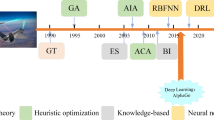Abstract
Icing encountered by an aircraft in flight can pose a great threat to flight safety, which is the foremost concern in aviation. Ice accretion has nonlinear and coupling properties, and therefore, a conventional envelope protection system cannot successfully deal with the condition. A safe flight envelope based on reachability analysis is proposed in this paper as a basis for designing an online envelope protection system for aircraft under icing conditions. This system uses a neural network method to identify changes in the aerodynamic coefficients and to classify the degrees of icing and uses a database-driven approach to solve the onboard safe flight envelope computation problem. The database of icing safe flight envelopes is created offline and can be retrieved in real time. The Research Civil Aircraft Model (RCAM) encountering icing conditions in the climbing phase was taken as an example to verify the feasibility of the online safe flight envelope protection system. The simulation results showed that the system can classify the degrees of icing efficiently, prevent the aircraft from deviating from the safe flight envelope, guide it back to the envelope along the fastest path, and reduce the risk of loss of control under icing conditions.












Similar content being viewed by others
References
Yihua C, Zhenlong W, Yuan S, Zhongda X (2015) Aircraft flight characteristics in icing conditions. Prog Aerosp Sci 74(1):62–80. https://doi.org/10.1016/j.paerosci.2014.12.001
Binbin P, Haojun X, Wei C (2015) In-flight icing risk prediction and management in consideration of wing stall. Aircr Eng Aerosp 6:147–174. https://doi.org/10.1108/AETA-06-2015-0147
Robert B. AOPA online Documents. http://www.aopa.org/asf/nubli-eations/sall.Pdf
Bragg MB, Breoeren AP, Blumenthal LA (2015) Iced-airfoil aerodynamics. Prog Aerosp Sci 41(41):323–362. https://doi.org/10.1016/j.paerosci.2005.07.001
Van O (2012) Adaptive backstepping control approach and safety analysis for modern fighter aircraft. Delft University of Technology, Netherlands
Wuji Z, Yinghui L, Liang Q (2017) Dynamic envelope determination based on differential manifold theory. J Aircr 54(5):2003–2007. https://doi.org/10.2514/1.C034258
Pandita R, Chakraborty A, Seiler P, Balas G (2009) Reachability and region of attraction analysis applied to GTM dynamic flight envelope assessment. In: Proceedings of the AIAA guidance, navigation and control conference, AIAA. https://doi.org/10.2514/6.2009-6258
Zhang Y, de Visser CC, Chu QP (2016) Online safe flight envelope prediction for damaged aircraft: a database-driven approach. In: Proceedings of the IAA modeling and simulation technologies conference, IAA. https://doi.org/10.2514/6.2016-1189
Lygeros J (2004) On reachability and minimum cost optimal control. Automatica 40(6):917–927. https://doi.org/10.1016/j.automatica.2004.01.012
Mitchell I (2007) The flexible, extensible and efficient toolbox of Level Set methods. J Sci Comput 30(1):68–77. https://doi.org/10.1007/s10915-007-9174-4
Alexandre B, Ian M, Meeko O (2008) Aircraft autolander safety analysis through optimal control based reach set. J Guidance Control Dyn 35(2):300–329. https://doi.org/10.1007/1.21562
Zhang Y, Visser C, Chu, CP (2016) Aircraft damage identification and classification for database-driven online safe flight envelope prediction. In: Proceedings of the AIAA atmospheric flight mechanic conference, AIAA. https://doi.org/10.2514/1.G002866
Tang L, Roemer M, Ge J (2009) Methodologies for adaptive flight envelope estimste and protection. In: Proceedings of the AIAA guidance, navigation and control conference, AIAA. https://doi.org/10.2514/6.2009-6260
Thomas J, Stefan R, Kevin R (2013) Safe maneuvering envelope estimation based on a physical approach. In: Proceedings of the AIAA guidance, navigation and control conference, AIAA. https://doi.org/10.2514/6.2013-4618
Bragg M, Hutchison T, Merret J (2000) Effect of ice accretion on aircraft flight dynamics. In: Proceedings of the AIAA aerospace science meeting and exhibit, AIAA. https://doi.org/10.2514/6.2000-360
Mitchell I (2002) Application of level set methods to control and reachability problem in continuous and hybrid systems. Standford University, California
Stefan S, Thomas L, Diana A (2017) Autonomous flight envelope estimation for loss-of-control prevention. J Guidance Control Dyn 40(4):847–862. https://doi.org/10.2514/1.G001729
Yihua C, Kungang Y, Guozhi L (2011) Effects of ice geometry on airfoil performance using neural networks prediction. Aircr Eng Aerosp Technol 83(5):266–274. https://doi.org/10.1108/00022661111159870
Basheer I, Hajmeer M (2001) Artificial neural network: fundamentals, computing, design, and application. J Microbiol Methods 43(1):3–31. https://doi.org/10.1016/S0167-7012(00)00201-3
Zhang L, Luo J, Yang S (2009) Forecasting box office revenue of movies with BP neural network. Expert Syst Appl 36(3):6580–6587. https://doi.org/10.1016/j.eswa.2008.07.064
Melody J, Basar T, Perkins R (2000) Detection and classification of aircraft icing using neural network. In: Proceedings of the 38th AIAA aerospace sciences meeting and exhibit, AIAA. https://doi.org/10.2514/6.2000-361
Zheng W, Li Y, Qu L (2017) Nonlinear stability region of icing aircraft during landing phase based on normal form method. Acta Aeronaut Astronaut Sin 38(2):567–588. https://doi.org/10.7527/S1000-6893.2016.0279(in Chinese)
Arun K, Gopal M (2009) Least squares twin support vector machines for pattern classification. Expert Syst Appl 36(4):7535–7543. https://doi.org/10.1016/j.eswa.2008.09.066
Bikash K, Swapan K (2011) Classification system using parallel genetic algorithm. Int J Innov Comput Appl 3(4):223–241. https://doi.org/10.1504/IJICA.2011.044569
Ou G, Murphey Y (2007) Multi-class pattern classification using neural networks. Pattern Recogn 40(1):4–18. https://doi.org/10.1016/j.patcog.2006.04.041
Paul L, Samir B, Gertjan L (1997) The RCAM design challenge problem description. Lect Notes Control Inf Sci 224(1):149–179. https://doi.org/10.1007/BFb0113858
Acknowledgements
This research was supported by the National Key Basic Research Program of China (No. 2015CB755805).
Author information
Authors and Affiliations
Corresponding authors
Additional information
Publisher's Note
Springer Nature remains neutral with regard to jurisdictional claims in published maps and institutional affiliations.
Rights and permissions
About this article
Cite this article
Yu, Z., Li, Y., Zhang, Z. et al. Online Safe Flight Envelope Protection for Icing Aircraft Based on Reachability Analysis. Int. J. Aeronaut. Space Sci. 21, 1174–1184 (2020). https://doi.org/10.1007/s42405-020-00266-7
Received:
Revised:
Accepted:
Published:
Issue Date:
DOI: https://doi.org/10.1007/s42405-020-00266-7




